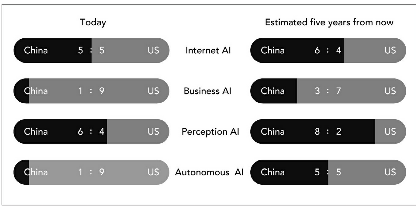
Why is the Progression of Japan’s AI Slow?
Last Updated on January 6, 2022 by Editorial Team
The die is cast…
AI and deep learning are not just “buzz words.” These technologies have been coming to cause an impact in the real world, especially in industry, i.e., automation, prediction, perception, and so on.
From a global point of view, the country leaders progressing in AI are the US and China, yet what about the next Asian tiger? Japan is struggling with implementing AI, machine learning, and deep learning technology advancements to the business world. Which it’s been caused by Japanese traditional business schemes for promotion, hiring, and management systems. This traditional system prevents Japan’s enterprises from generating new AI ideas, implementation, and so-on.
This article will try to unveil the hidden Japanese stacking reasons for accepting AI technology advancements in the business world.
AI World Top 2; the US and China — Any possibility for Japan?
Dr. Kai-Fu Lee, the author of “AI Superpowers,” is one of the world’s most respected experts on AI. His meaningful work has been fountained from his China-oriented experiences and education in America. This inspiring book tells us the AI realization level in the US and China as below.

China is following the US in terms of Business AI and Autonomous AI; however, it will undoubtedly grow against the US within five years. The more dramatic change will happen in Internet AI, Perception AI, and Autonomous AI to catch up and beat the US. For a long time, China had been an excellent hardware production base, creating IC or converters to support the 1980s’ manufacturing in Japan though, we would say one sad news for the Japanese is that they had surrendered the position as an AI leader to China at all. Of course, more and more Japanese enterprise companies have tried to generate innovations with AI/deep-learning technologies robust, most of them are genuinely stacking for it.
Dr. Yutaka Matsuo is famous as one of the academic AI researchers in Japan, working as a professor at the University of Tokyo (UT) and contributing to artificial intelligence, especially on deep learning and data mining. He clearly stated one point of view that in the book by Dr. Kai-Fu, Japan has never mentioned about entirely, and that is the problem for Japan. This means Japan does not get on to the same stage with the US and China about AI / deep learning practical use for industries. Although Dr. Matsuo believes that Japan will be able to speed up and be stronger in Perception AI and Business AI fields in the future, it might take a long time to achieve.
Does a Japanese old fashion scheme lead to slow AI?
Have you ever heard about the Japanese seniority/lifelong employment or mass hiring for new graduates in Japan? These are not based on personality knowledge and skills for individuals and estimate them as “how many years have you stayed and contributed for companies?” (it means the longer is better) And “Can you have loyalty for a company?”. These old schemes have been lasting since the 1960s.
These traditional rules kill a high generation with cutting-edge technologies. Thus, in May 2019, the head chief on Japan Business Federation, Hiroaki Nakanishi declared these legacies should be changed in a few years. The lifelong employment allows many management people who are conservative to change with AI / deep learning to stay longer in companies and prevents young incubators from releasing great ideas. If the Japanese HR system changes drastically, it will help the managers change the mindset and open for technologies.
On the other hand, a hopeful change has happened in Japan. Itochu Corporation is one of the biggest and traditional trading companies. The giant company announced to build a small brand-new division for the market in incubation, comprising with only 40 young employees. And they are all ambitious, under 30-year-old and empowered to try innovative projects. This is believed for Itochu to get fresh air for a market-oriented perspective and utilize new technologies like AI/deep learning for the business more.
Many powerful East Asian countries surround Japan. To catch up with them and generate more, there is no choice but to circle back and look at Japanese organizations’ traditions first to come up with better strategies to take advantage of AI-technologies in business. Yes, the die has been cast.
We’ll keep an eye for technological challenges and changes in Japan.
Take our 90+ lesson From Beginner to Advanced LLM Developer Certification: From choosing a project to deploying a working product this is the most comprehensive and practical LLM course out there!
Towards AI has published Building LLMs for Production—our 470+ page guide to mastering LLMs with practical projects and expert insights!

Discover Your Dream AI Career at Towards AI Jobs
Towards AI has built a jobs board tailored specifically to Machine Learning and Data Science Jobs and Skills. Our software searches for live AI jobs each hour, labels and categorises them and makes them easily searchable. Explore over 40,000 live jobs today with Towards AI Jobs!
Note: Content contains the views of the contributing authors and not Towards AI.












